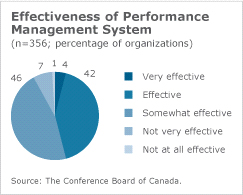Assessing Employee Performance
By Karla Thorpe
Performance appraisals can be stressful and are often dreaded by both the manager that needs to deliver the appraisal and the employee being evaluated. And yet a recent Conference Board report, Performance Management: Turning Individual Stress to Organizational Strategy, found that performance reviews are nearly universally-used in Canadian organizations.
So why do organizations continue to evaluate the performance of their employees? It is certainly not because they feel their performance management systems are effective. In fact, the survey found that only about half (46 per cent) of organizations survey described their performance management systems as being effective. The rest of the respondents felt their systems were either neutral or ineffective in terms of boosting employee performance.
 As you might imagine from these results, often employees and managers aren’t committed to the process. The process takes time and is often not seen as a good use of time. So companies struggle with getting the evaluations submitted on schedule—or, in some cases, at all. Organizations may maintain their ineffective systems simply out of routine. It is also possible that revamping the performance management system is on that bucket list of systems to improve . . . someday.
As you might imagine from these results, often employees and managers aren’t committed to the process. The process takes time and is often not seen as a good use of time. So companies struggle with getting the evaluations submitted on schedule—or, in some cases, at all. Organizations may maintain their ineffective systems simply out of routine. It is also possible that revamping the performance management system is on that bucket list of systems to improve . . . someday.
Evaluating employees’ contributions is not a science. Many items employees are evaluated against–such as their competencies and behaviours–are not easily quantifiable. Therefore, ensuring the performance system is consistent and fair, even for employees working under the same manager, is no easy task.
And then there is the system itself. Often, it is a complex paper-trail in which forms get shuffled from one person to the next until they find their home somewhere in HR (if they get there). This routine is not helpful to organizations in terms of analyzing—at a high level—the overall performance levels, identifying collective areas for further training and development, and tracking individuals’ performance over time.
Despite all of these issues, there are few signs that performance appraisals are going away. At a minimum, companies can work to make sure that the process can align individual goals to organizational ones, substantiate merit-based salary increases, and document the performance of employees who are under-performing. From a more tactical perspective, appraisals serve as an opportunity for employees and managers to discuss progress and accomplishments, and address any concerns about how employees are performing.
Eight tips for improving the effectiveness of performance management systems:
- Keep the process simple
- Communicate the process clearly so employees and managers know why, how, and when to act
- Ensure employees and managers are held accountable for holding up their end of the bargain
- Make sure executives lead by example
- Set cascading goals that link an employee’s individual goals and objectives with those of the organization
- Reward top performers for their accomplishments
- Provide training to managers on how to provide meaningful feedback and give objective ratings
- Ensure fairness and objectivity
By implementing these tips, employers can help shift the performance management process from a stressful and ineffective process to one that improves individual and organizational performance. Learn more in Performance Management: Turning Individual Stress to Organizational Strategy.
Karla Thorpe is Director, Leadership and Human Resources Research
Originally published on ConferenceBoard.ca.








